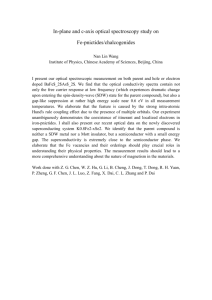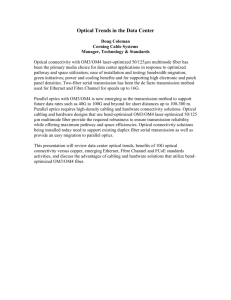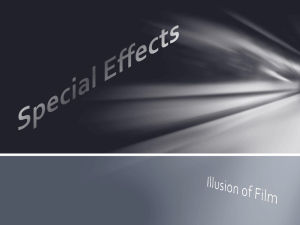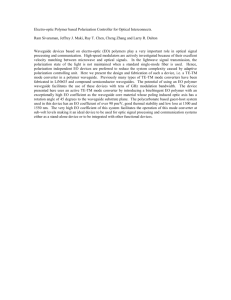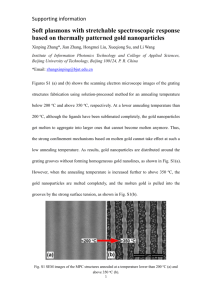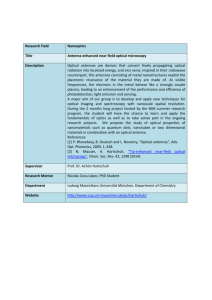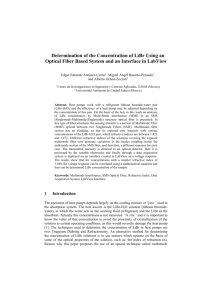An Optical Switch of Natural Light Guiding System Based on Cubic
advertisement
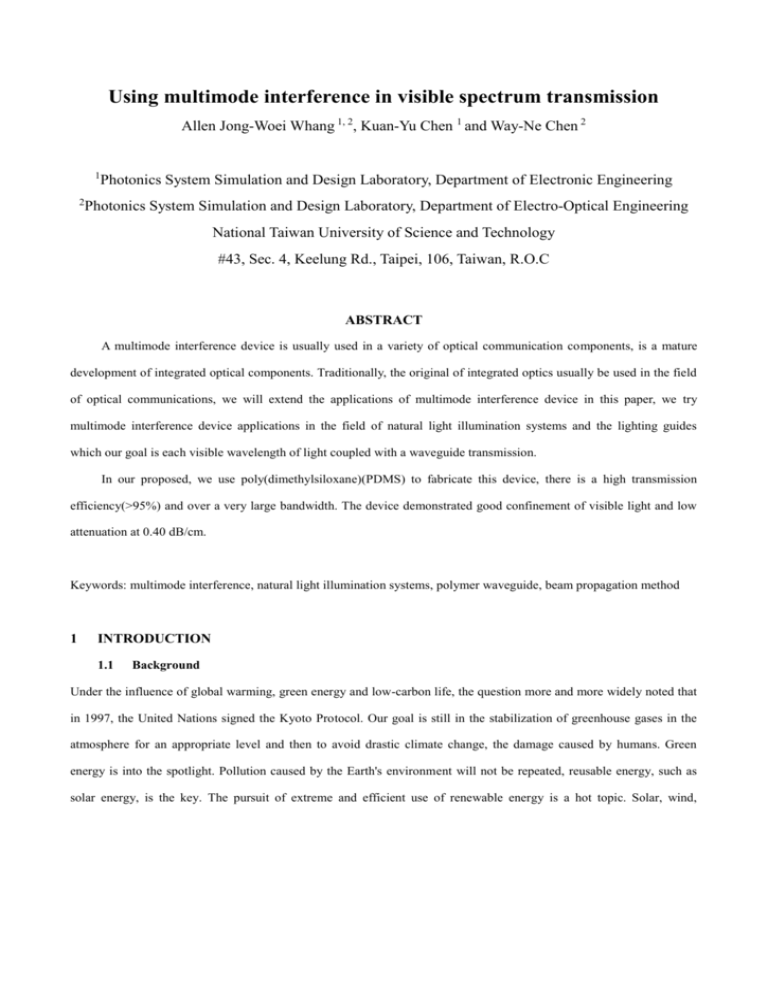
Using multimode interference in visible spectrum transmission Allen Jong-Woei Whang 1, 2, Kuan-Yu Chen 1 and Way-Ne Chen 2 1 2 Photonics System Simulation and Design Laboratory, Department of Electronic Engineering Photonics System Simulation and Design Laboratory, Department of Electro-Optical Engineering National Taiwan University of Science and Technology #43, Sec. 4, Keelung Rd., Taipei, 106, Taiwan, R.O.C ABSTRACT A multimode interference device is usually used in a variety of optical communication components, is a mature development of integrated optical components. Traditionally, the original of integrated optics usually be used in the field of optical communications, we will extend the applications of multimode interference device in this paper, we try multimode interference device applications in the field of natural light illumination systems and the lighting guides which our goal is each visible wavelength of light coupled with a waveguide transmission. In our proposed, we use poly(dimethylsiloxane)(PDMS) to fabricate this device, there is a high transmission efficiency(>95%) and over a very large bandwidth. The device demonstrated good confinement of visible light and low attenuation at 0.40 dB/cm. Keywords: multimode interference, natural light illumination systems, polymer waveguide, beam propagation method 1 INTRODUCTION 1.1 Background Under the influence of global warming, green energy and low-carbon life, the question more and more widely noted that in 1997, the United Nations signed the Kyoto Protocol. Our goal is still in the stabilization of greenhouse gases in the atmosphere for an appropriate level and then to avoid drastic climate change, the damage caused by humans. Green energy is into the spotlight. Pollution caused by the Earth's environment will not be repeated, reusable energy, such as solar energy, is the key. The pursuit of extreme and efficient use of renewable energy is a hot topic. Solar, wind, hydropower, ocean energy, geothermal energy and biomass are renewable energy. In renewable energy research, the most important issue is how to use energy efficient. In renewable energy, solar energy has many advantages, an abundance of natural and clean. In addition, it is a global energy, so we can use it anywhere in the world. This article how to collect the sun's interior lighting is our ultimate goal. 1.2 Motive Major reasons for many natural light illumination systems are high capital cost. And there is a lot of cost about the transmission, in traditional are using optical fibers or reflection light pipe. There are expensive manufacture costs of those two elements. Therefore we proposed using the MMI structure to guide the visible spectrum and makes those could be used in long distance transmission and indoor illumination. 2 BASIC THEORY AND PRINCIPLES 2.1 System structure Saving energy and reducing carbon dioxide are among the most critical global issues. Therefore, solar energy should be used as much as possible. One method is photovoltaic generation to convert sunlight directly into electricity [1,2] . However, low efficiency and high cost are the drawbacks. In addition, there is a system which is able to gather natural light for indoor lighting. It can save 80 percent of the energy used by traditional lighting [3,4] . This is the Natural Light Guide System. In this study, we mainly design a new light pipe with optical structures in the light transmitter system. The Natural Light Guiding System consists of three parts:the light collector, the light transmitter, and the light emitter, shown in Fig1. In the light collector part, using the sunlego to collect sunlight, the theorem about sunlego use is to collect sunlight and use total reflection to effectively compress the light by prism total internal reflection. That is to change the surface light source into a linear light source or point source, shown in Fig2. The element in the transmitting part is optical fiber. Optical fiber can transmit the collected light to our wish place with the least loss. Although the optical fiber will increase the cost, in this time fiber is the first choice. The optical fiber we would like to design is placed in this part, as shown in the Fig. 3. Fig. 1 A schematic diagram of the Natural Light Guiding System. Fig. 2 The light collector of the natural Light Guiding System. Fig. 3 Figure the circle in part connections with fiber. 2.2 Multimode interference device Self-imaging of periodic objects illuminated by coherent light was first described more than 170 years ago [5] . The multimode waveguide region is designed so that its length coincides with one of the self-imaging planes at its output, so that, for example, each input waveguide is imaged onto one output waveguide. This self-imaging phenomenon, which arises in multimode optical waveguides, can be used to image a small spot size beam into the middle of a micro channel. Shows in fig.4 single images of the input field, the length of MMI section should be designed to fulfill the following condition: Lmmi m( Lx ) n(3Ly ) where m and n are odd integers. In the paired and general excitations [6] are assumed to apply to the x and y dimensions, respectively. Fig. 4 The single images of the input field 3 Multimode interference device of visible spectrum 3.1 Material Polydimethylsiloxane (PDMS) is one of the most widely used flexible silicone elastomers. It is an ultra-violet transparent, gas permeable silicon-based, organic, cross-linkable polymer that can withstand a wide temperature range. Due to its numerous outstanding material properties PDMS is applied in more and more fields in science and industry: e.g. it is very common in biology-related experiments and in clinical practice due to its low toxicity or biocompatibility, but as replication molds or stamps it is also frequent in the field of nano or micromachining technology. PDMS is often used to create microfluidic devices, such as separation systems, micro-mixers or even diagnostic chips e.g. for DNA analysis. Due to the high optical clarity, low attenuation and the excellent chemical stability PDMS is great choice to create optical components. Since this polymer is a good replicating material the optical structures (waveguides, microlenses, etc.) are usually created by amolding process, in which PDMS is first coated on to and then peeled off from a rigid mold, or with imprinting technology. The PDMS waveguide demonstrated good confinement of light and relatively low attenuation at 0.40 dB/cm. also has very high light transmittance ( 95%) over a large frequency range. 3.2 Simulation and design The size of waveguide was fixed at 20μm width and a change in fixed-width waveguide length for different wavelengths. There are different length in visible spectrum that red light 1990μm, green light 2550μm and blue light in the PDMS waveguide. Three wavelength self-imaging point by using the least common multiple of the calculation, the main point of the RGB wavelength with the position at148 cm. Fig.5 The green light distribution of energy propagation Fig.6 The red light distribution of energy propagation Fig.7 The blue light distribution of energy propagation 4 CONCLUSION After we proposed the concept of using multimode interference in visible spectrum Provides a new approach about the natural light illuminations system in indoor illumine. In the future We hope to be able to improve the transmission of different wavelengths caused by the imaging point of difference, through the structure and choice of materials, making the imaging point more gathered together in a different wavelength of visible light spectrum. REFERENCE [1] Wehrmann, A., Puttnins, S., Hartmann, L., Ehrhardt, M., Lorenz, P., Zimmer, K. “Analysis of laser scribes at CIGS thin-film solar cells by localized electrical and optical measurements,” Optics and Laser Technology 44:1753-1757 (2012) [2] AlHajri, M.F., El-Naggar, K.M., AlRashidi, M.R. , Al-Othman, A.K. “Optimal extraction of solar cell parameters using pattern search,” Renewable Energy 44:238-245(2012) [3] Whang AJW, Chen CC, Chen YY. “Design, analysis, and fabrication of cascadable unit of static concentrator by prismatic structure for indoor illumination,” Proc. of the APOC, Taipei, Taiwan (2009) [4] Chou KH, Chen YY, Whang AJW, “An optical switch of natural light guiding system based on cubic structure with Fresnel surface,” Proc. of SPIE 7428, 74280 (2009) [5] R. van Roijen, E. C. M. Pennings, M. J. N. van Stralen, T. van Dongen, B. H. Verbeek, and J. M. M. van der Heijden, “Compact InP-based ring lasers employing multimode interference couplers and combiners,” Appl. Phys. Lett., vol. 64, no. 14, pp. 1753-1755, (1994) [6] L. B. Soldano and E. C. M. Pennings, “Optical multi-mode interference devices based on self-imaging: Principles and applications,” J. Lightw. Technol., vol. 13, pp. 615–627, Apr. (1995)
